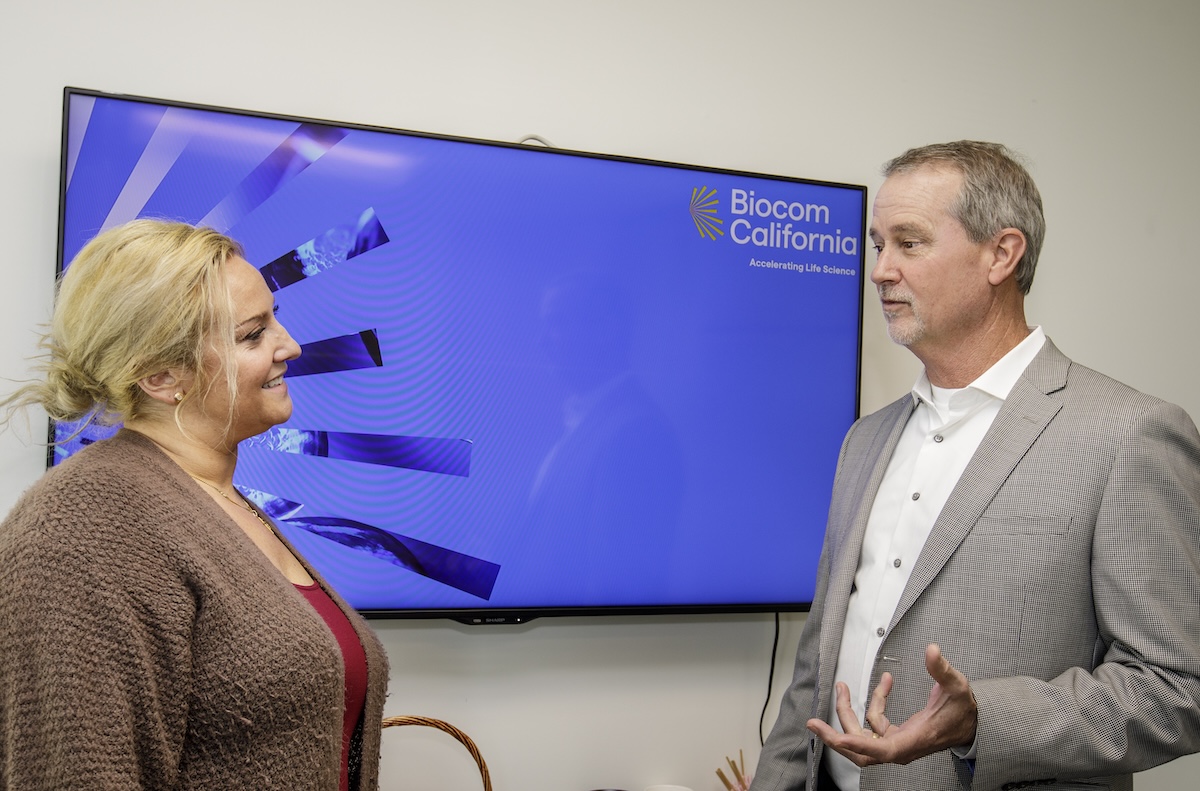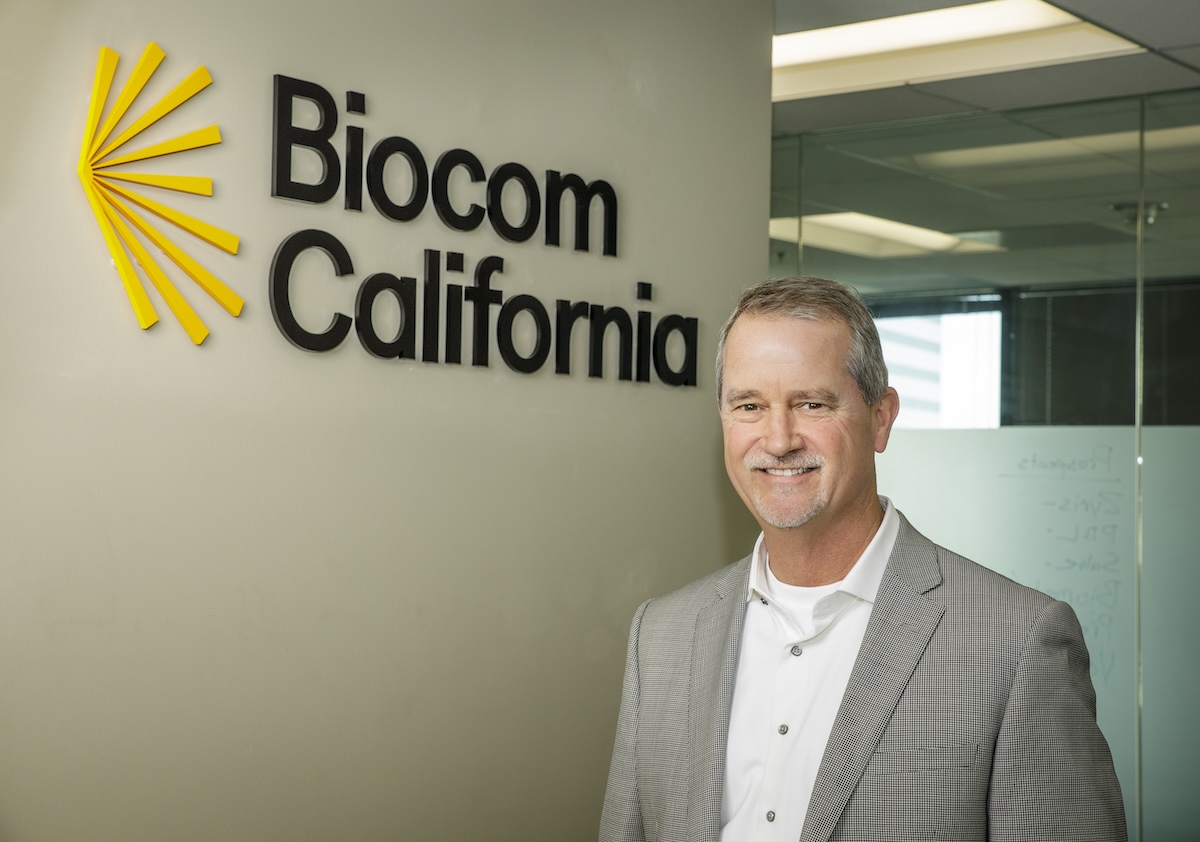In his role as the new executive director of the Los Angeles chapter of statewide industry resource and advocacy group Biocom California, Dan Gober’s goal is to provide a boost to the region’s bioscience industry and its local microclusters.
Gober came on board Biocom’s Los Angeles chapter late last year, replacing Stephanie Hsiesh, who left to helm a new initiative, Grow L.A. Bio, which is sponsored by the Los Angeles County Economic Development Corp., Biocom, Bioscience LA and the LARTA institute.
Prior to joining Biocom, Gober was himself involved in several companies that dealt with the region’s bioscience startups, most recently with Corval, a Boston-based platform that provides commercialization resources for bioscience companies. Earlier in his career, Gober spent 17 years as a pharmaceutical sales rep for Southern California and then statewide for what eventually became pharma giant AstraZeneca, which is based in Cambridge in the United Kingdom.
Gober sat down with the Business Journal to discuss the region’s bioscience microclusters, what can be done to boost them and a recent Biocom success in helping pass industry-friendly regulations in Pasadena.
How and why did bioscience microclusters develop in the Los Angeles region?
These microclusters more or less developed independently and organically out of certain key research centers. These centers are spread out geographically around the region, from Thousand Oaks to Pasadena to the South Bay.

What are these research centers and what has been their role?
For the most part, they are research universities that attract research dollars, including UCLA, City of Hope, Caltech, USC, and the Lundquist Institute down in the South Bay. Most of these research centers have incubators specifically designed to help researchers with therapeutic technologies to launch and grow companies. I’m thinking especially of the Magnify incubator at UCLA.
Amgen is a bit different, though.
Yes, Amgen scientists over the years broke off from the company to form their own companies nearby and that’s how the 101 Biotech Corridor got started.
Why has it been so difficult to turn these microclusters into one giant megacluster to rival the Bay Area, San Diego or Boston?
The Los Angeles region isn’t a compact area like La Jolla or the South Bay region of San Francisco or Cambridge in the Boston area. Also, because of these distances and the time it takes to travel between them, it’s difficult to go to and from meetings within different clusters, so there has been relatively limited interaction between the microclusters.
Has Biocom tried to change this and bring these microclusters closer together – maybe even create a megacluster?
We have held forums that bring bioscience industry leaders together, including one last fall that drew CEOs from more than 80 companies spread throughout all the microclusters. It was great, for example, to see Basil Dahiyat (the chief executive of Xencor Inc. in Pasadena) get to know and work closely with Frank Watanabe (the chief executive of Arcutis Biotherapeutics Inc. in Westlake Village).
But Biocom’s aim is not to create a megacluster; it’s to boost the companies within each of these microclusters and build resources for all the bioscience companies within the region.
Why has the Los Angeles region lagged considerably behind the Bay Area, San Diego and Boston in attracting venture capital dollars?
VCs have to have a belief that bioscience companies can grow here. They are only now just starting to come around. Ten years ago, the typical conversation between local startups and VCs was, ‘We love your technology and see that you are ready to spin out of the Magnify incubator at UCLA, but now that you’re ready to grow you really need to locate in Silicon Valley or Boston.’

Is this view changing?
The VCs are changing their attitude now because they are seeing more success stories of companies growing here. Look at Capsida in Thousand Oaks (which debuted three years ago with $140 million in venture capital), or Kite Pharma in Santa Monica (which was sold to Foster City-based Gilead Sciences in 2017 for nearly $12 billion) or Protomer Technologies in Pasadena (which was acquired in 2021 by Eli Lilly and Co. for upwards of $1 billion).
Another factor has been the establishment of Westlake Village Biopartners, a homegrown VC company (in 2018). That has shown other VCs that you can thrive by making investments in the Los Angeles bioscience marketplace.
We’ve had a major development in the Westside microcluster in recent weeks with the announcement of the California Immunology and Immunology Center, run by UCLA at the former Westside Pavilion. How do you expect this to impact the microcluster picture here?
Well of course it will boost the profile of the that Westside microcluster. But this immunology center has the potential to do a whole lot more. Right now, our local research centers are good at spawning companies that then can grow in the region. But this center can attract people from outside the region to come here. If you are in the immunotherapy space, once this center is up and running, then no matter where you are in this country – be it Boston or Texas – you will have to reckon with whether you need to have a presence in Los Angeles.
And can this benefit other microclusters besides the Westside area immediately around UCLA?
Yes, and that’s where an organization like Biocom can come in. We can reach out to companies in the immunotherapy space that are considering establishing a presence here and help direct them to affordable space and facilities in any of our microclusters.
You’ve been involved for several years with helping bioscience companies grow. How did that come about?
I can trace it back to the time I spent as a regional pharmaceutical sales rep in the late 1980s for what became AstraZeneca. I focused on the users of their pharmaceutical products, and that included research institutions such as UCLA and City of Hope.
More recently, I worked for companies such as Health Strategies Groupand Corval, that worked with emerging life science companies. At Corval especially, my role was getting to know emerging life science companies throughout California.
That’s where I first got exposure to the microclusters developing here in the Los Angeles region and first ran into the question about why Los Angeles isn’t considered in the same ranks as the Bay Area, Boston and San Diego.
What is your main goal at Biocom?
Biocom reached out to me last year with the goal of helping to bring L.A. into the same ranks as these other major metro areas when it comes to life science companies.
Any other goals?
Within that larger goal, I have two other goals: getting the microclusters to coexist and support each other more and making the local governments in the region more hospitable to life science companies.
On the first goal, I’m trying to lead an effort for more cross-pollination of ideas, more networking and especially more face time for local startups with VC firms. On that second goal, we’ve just scored a major success in Pasadena.
What happened in Pasadena?
We just got a major package of regulatory reforms passed in Pasadena that should make it considerably easier for life science companies to locate and remain there.
About a year ago, the city manager in Pasadena pulled together life science company reps and asked one question: ‘What can we do to make life easier for you here in Pasadena?’
The response from the industry: The city should make building permit regulations more flexible, particularly when it comes to ceiling heights, ventilation, onsite equipment permitting, waste disposal regulations and onsite parking. This working group brought a package of regulatory changes to the Pasadena City Council and the council passed this at the end of last year.
Business taxes have long been a major gripe of businesses across the board. Did this package of reforms include any changes on that front?
No. We focused on the regulatory changes.
Does getting this set of regulatory reforms passed in Pasadena carry any significance for the bioscience industry beyond that city?
Yes. This was one of the first places where we saw the rubber meet the road and actually made some changes.
We now have an example of a city in Los Angeles County that has made these changes and that can be used as a template for other cities, including the city of Los Angeles and the county.
Also, by making the permitting rules more flexible, it should be easier to site wet lab and other facilities vital to the industry in Pasadena. There’s a shortage of common wet lab space that startups can use to develop their therapies. (Wet labs allow researchers to safely experiment with liquids as they develop their drugs.)
Any other goals that you have for Biocom?
Yes. Growing the roster of our member companies is a key goal. We need to show them the value we can bring to make an impact, both in government policy and in making resources available. On the government policy, we have just shown what we can do in Pasadena.